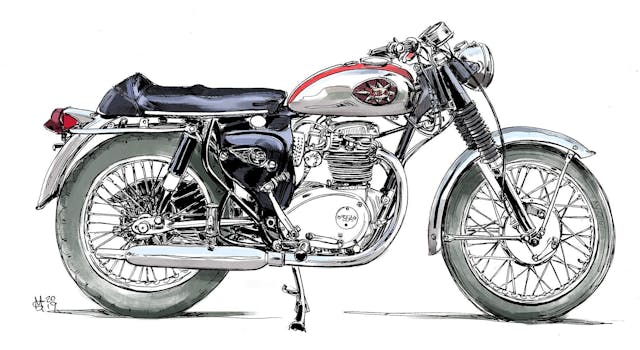Stock Stories: 1966 BSA A65 Lightning
With custom bike culture exploding in recent years, the history and importance of the two-wheeled machines that first rolled off of the production line are often overlooked. Stock Stories tells the tales of these motorcycles.
Up until the early 1960s, BSA was the largest producer of motorcycles in the world. The 1950s had been a good decade for the marque, with the success of the Gold Star as well as the development of two well-respected pre-unit (separate gearbox and engine), vertical twin-engine series: the A7 and A10. Not only was BSA a giant in producing motorcycles, the company also manufactured other goods such as buses, agricultural equipment, bicycles and, of course, weapons. Flush with cash generated from this diversified business, BSA also bought up other motorcycle marques—Triumph and Ariel, among others—making it a true empire.
For any business to survive it needs to be constantly ahead of the competition, on the look-out for the next big thing to make its product stand out. When the early 1960s arrived, the design trend in motorcycles had shifted to a more simplified and enclosed look, more akin to automotive design. BSA was, however, fairly conservative with its design philosophy, and only for the 1966 BSA A65 Lightning did the company shows initial leanings toward more simplified design choices. Holding onto the success of its 1950s machines, BSA perhaps felt that totally reimagining the bike might alienate its loyal audience. These mid-1960s BSAs are great examples of the transition between the more established British bike look and a more forward-looking 1970s style.

The BSA Lightning appeared in film and television on a few occasions, the most notable being the 1965 James Bond film Thunderball. SPECTRE agent Fiona Volpe, played by Italian actress Luciana Paluzzi, rides a fully-faired gold Lightning armed with rocket launchers. In the famous scene, Volpe uses the rockets to blow up a black car chasing Bond’s Aston Martin DB5, a scene that is etched into many people’s minds. Filmed at Silverstone, the Lightning was actually ridden on track by motorcycle champion Bill Ivy—in a blonde wig!
Designed as an all-round sports machine, the Lightning was one of various A65 models designed be sold predominantly in the U.S. market, such as the Thunderbolt, Rocket, Spitfire, and Hornet models, along with sub variants such as the Lightning Rocket and Lightning Clubman. The Lightning was made between 1965 and 1972, and the bike illustrated here is from the early end of that spectrum. At the time it was a top-of-the-range machine, and the first to use 12-volt electrics. BSA had developed it to compete with the Triumph Bonneville. Some say it was the styling of the Lightning versus the Bonneville that let it down; the former’s performance and handling were certainly competitive.
As mentioned, our main A65 illustration showcases a few design elements that are distinctly traditional, namely the front and rear ends, but even the fuel tank to a certain extent is not too radically different from that of the earlier BSA A10 from which the Lightning evolved. It is the design of the engine and the oil tank that distinguish this machine from its forerunner.

In the late 1950s, Lucas switched its production of electronic motorcycle components from magneto and dynamo to alternator and coil systems. This change instigated a major change in British motorcycle engine design. BSA and Triumph (at this time owned by BSA) took the opportunity to completely redesign its engine ranges, moving away from pre-unit and semi-unit construction to full-unit construction. Full-unit construction meant combining the engine and gearbox into one complete unit. The A65 was one such engine, the product of lessons learned from the A10 engine that BSA Managing Director and General Manager Bob Fearon worked on with Bert Perrigo, Chief Development Engineer, to create the new vertical twins.
When it came to the unit construction of the A65, the outer cases were minimal in their sculpting, shaped into simple domed ovals; this became known as “The Power Egg.” Due to the investment in redesigning, tooling, and producing this new construction, “The Power Egg” stuck with BSA until the brand’s demise in 1973.
The A65 engine was designed to be quieter, more reliable, and less prone to oil leaks than its predecessors. When you take into account that, by 1969, 80 percent of BSAs production was going to the States, these were sensible goals. In America, reliability over longer distances and quieter running in urban environments were key selling points, favored by civilian customers and authorities alike. Later styling changes to the Lightning range—such as high rise handlebars and more streamlined fuel tanks—also targeted the American market in an effort to drive sales.
The A65 and its smaller variant, the A50, ultimately proved to be good engines. Both were continually developed throughout the late 1960s, and some say the peak of the A65 series was the 1970 model. Various problems during this time included oil pump issues, and oiling in general; BSA never fully resolved these issues, however with modern solutions these engines are still considered very usable within the classic motorcycle world.
The Lightning received a slightly modified version of the A65 engine, featuring a close-ratio gear box and a high-lift camshaft. This yielded lively acceleration characteristics and solid performance at higher rpm, though the close-ratio ‘box with its tall first gear meant that the rider would have to slip the clutch up to 10 mph.
With BSA back in the news and eyeing a 2021 comeback, there’s never been a better time to celebrate the classic British brand and its beloved machines.


